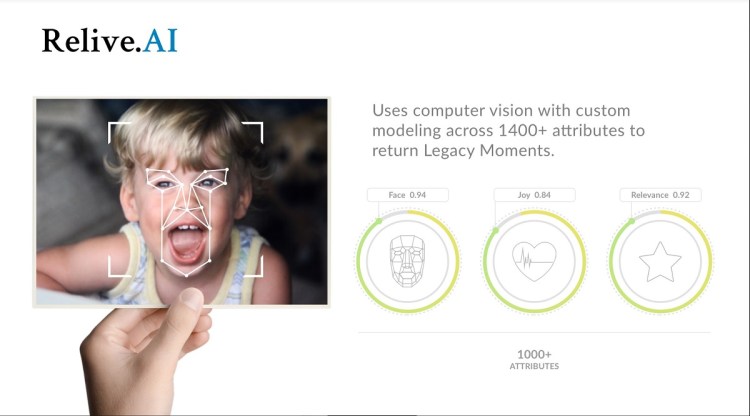Legacy Republic has helped people recapture their memories by converting old analog photos and videos into digital form on mobile and the web. Now it is taking this a step further by taking advantage of Google Photos and Google Cloud, as well as artificial intelligence to sort through our pictures.
At the Google I/O event on Tuesday, Legacy Republic announced that it has joined the Google Photos Partner Program to enable consumers to combine their collections of old and new photos alike. And Legacy Republic is also creating Relive.AI, a machine learning-based image recognition system that uses computer vision models to automatically select a set of family moments and build photo albums.
With Relive.AI, Legacy Republic hopes to get rid of the laborious process of manually selecting good photos and putting them into photo albums to share with friends and family. More than five trillion photos were taken in the past four years, but the photo commerce industry has not responded to this massive expansion of customer behavior, the company said.
“More than a trillion new photos are taken each year, and so many are also unseen in attics and closets. The photo commerce industry is a $3 billion industry, and most people feel unserved by it. It’s broken. We’ve brought a lot of technologies together, and it’s going to change the photo commerce industry,” cofounder and CEO Brian Knapp said. “I feel we were lucky to get a key insight into what I think was broken about that industry. This is like introducing the Stitch Fix of photo commerce,” referring to the fashion industry service that helps you find better outfits.
June 5th: The AI Audit in NYC
Join us next week in NYC to engage with top executive leaders, delving into strategies for auditing AI models to ensure fairness, optimal performance, and ethical compliance across diverse organizations. Secure your attendance for this exclusive invite-only event.
Knapp said that a distressing challenge of modern life is that we have more evidence of our memories than ever before, but we hardly ever revisit the moments in our camera roll — from that selfie while summer backpacking abroad to the videos of our children’s first steps. At the same time, vintage slides, negatives, prints, and photo albums, along with the rich family legacies encompassed within, remain tucked away on obsolete and at-risk analog formats.

Above: Legacy Republic’s Relive.AI looks for Legacy Moments.
Legacy Republic will be one of the first companies to launch later this year as part of the Google Photos Partner Program. With this offering, your vintage memories will now all be organized, searchable and shareable from Google Photos, for powerful experiences from the early 1990s through today.
“It’s amazing how fast and accurate computer vision has gotten,” Knapp said. “We’re going to try to read your mind to capture meaningful moments.”
Currently, Google Photos’ Then and Now feature pulls up past and present photos of the recurring faces in your photo album and organizes them side by side for a fun, nostalgic look at how your children, siblings, friends, and more have grown over the years. With Legacy Republic, those using Google Photos can now enjoy photos taken decades before the smartphone era.
Legacy Republic starts with a Memory Makeover, the easiest way to get your vintage memories modernized. Memory Makeovers are available as convenient mail-in kits for photo prints, slides, negatives, and home movies. In-home services are available for photo albums and scrapbooks in select locations. Legacy Republic transfers your pre-digital memories into an online Family Legacy account.
“As we develop this model for an ideal moment, we think about creating Legacy Moments, which trigger a strong emotional response from the consumer and yet uphold standards for quality photos,” said Ben Giang, vice president of product at Legacy Republic, in an interview. “We can do this 1,000 times faster than a person can.”
From there, since Legacy Republic’s Memory Makeovers integrate with Google Photos, customers can transfer scanned photos to their Google Photos library to use Google Photos features such as auto-grouping, searching by places, people, and things, and GIF creation to relive and share their memories.
This new solution was announced on Tuesday during Google I/O. Legacy Republic has already begun testing of its integration, with the public customer release planned for later in 2018.

Above: The photo commerce industry is failing consumers.
Meanwhile, Legacy Republic’s computer vision engine Relive.AI identifies “Legacy Moments” for you. Relive.AI curates your images using cues such as human emotion, image objects and framing, landscapes and landmarks, and era.
With thousands of photos on your desktop and mobile device, it is nearly impossible to find the most important moments to even begin creating photo decor and gifts. Relive.AI models score memories against a proprietary algorithm to select the right moments.
And finally, Legacy Republic offers white-glove delivery for a next-generation, personalized photo commerce experience. The company’s designers use their styling expertise to match your Legacy Moments with unique, curated decor, jewelry, and gifts.
Legacy Republic’s founding team spun off from memory transfer company YesVideo in 2017, where it originated as a direct consumer sales channel. I used YesVideo to transfer my old photos and videos to digital form, but I haven’t created any cool photo albums lately.
That’s exactly the problem, Knapp said.
“You’re taking more photos and not creating anything,” he said. “That whole industry has moved in this do-it-yourself direction. But people aren’t creating digital albums.”
Knapp said the company is looking for new funding now.
“I think we have a winning formula for a space that has not been reinvented,” Knapp said.


